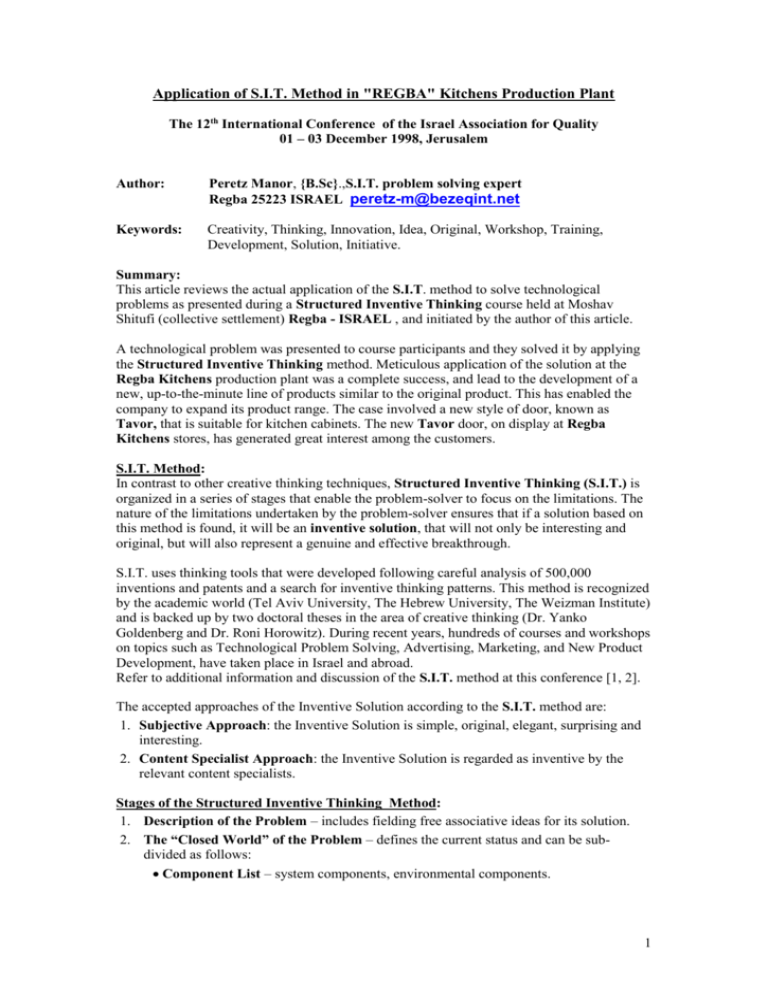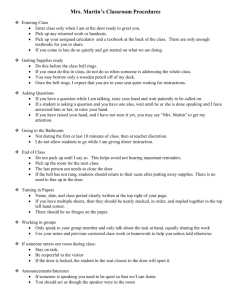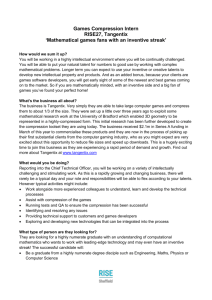
Application of S.I.T. Method in "REGBA" Kitchens Production Plant
The 12th International Conference of the Israel Association for Quality
01 – 03 December 1998, Jerusalem
Author:
Peretz Manor, {B.Sc}.,S.I.T. problem solving expert
Regba 25223 ISRAEL peretz-m@bezeqint.net
Keywords:
Creativity, Thinking, Innovation, Idea, Original, Workshop, Training,
Development, Solution, Initiative.
Summary:
This article reviews the actual application of the S.I.T. method to solve technological
problems as presented during a Structured Inventive Thinking course held at Moshav
Shitufi (collective settlement) Regba - ISRAEL , and initiated by the author of this article.
A technological problem was presented to course participants and they solved it by applying
the Structured Inventive Thinking method. Meticulous application of the solution at the
Regba Kitchens production plant was a complete success, and lead to the development of a
new, up-to-the-minute line of products similar to the original product. This has enabled the
company to expand its product range. The case involved a new style of door, known as
Tavor, that is suitable for kitchen cabinets. The new Tavor door, on display at Regba
Kitchens stores, has generated great interest among the customers.
S.I.T. Method:
In contrast to other creative thinking techniques, Structured Inventive Thinking (S.I.T.) is
organized in a series of stages that enable the problem-solver to focus on the limitations. The
nature of the limitations undertaken by the problem-solver ensures that if a solution based on
this method is found, it will be an inventive solution, that will not only be interesting and
original, but will also represent a genuine and effective breakthrough.
S.I.T. uses thinking tools that were developed following careful analysis of 500,000
inventions and patents and a search for inventive thinking patterns. This method is recognized
by the academic world (Tel Aviv University, The Hebrew University, The Weizman Institute)
and is backed up by two doctoral theses in the area of creative thinking (Dr. Yanko
Goldenberg and Dr. Roni Horowitz). During recent years, hundreds of courses and workshops
on topics such as Technological Problem Solving, Advertising, Marketing, and New Product
Development, have taken place in Israel and abroad.
Refer to additional information and discussion of the S.I.T. method at this conference [1, 2].
The accepted approaches of the Inventive Solution according to the S.I.T. method are:
1. Subjective Approach: the Inventive Solution is simple, original, elegant, surprising and
interesting.
2. Content Specialist Approach: the Inventive Solution is regarded as inventive by the
relevant content specialists.
Stages of the Structured Inventive Thinking Method:
1. Description of the Problem – includes fielding free associative ideas for its solution.
2. The “Closed World” of the Problem – defines the current status and can be subdivided as follows:
Component List – system components, environmental components.
1
3.
4.
5.
6.
7.
Technological Concept – understanding the existing underlying concepts of the
system.
Qualitative Analysis – analyzing which of the technological concepts should be
retained.
Functions Chart – serves as a tool to help internalize the underlying concept and the
functional correlation between the components.
Discussion Levels – differentiating between macro, micro, functionality,
supplementary, etc.
Conditions for Qualitative (or Significant) Change – this condition forces us to search
for an inventive solution by presenting a structured conflict.
Exposition – implementation of thinking tools such as unification, multiplication,
inversion, addition of new dimension, division, reduction.
Selecting an Idea – selecting, elaborating and processing an idea until it takes the form
of a practical solution.
Solution Review – if the solution is unsatisfactory, the S.I.T. process requires the
problem-solver to return to the Underlying Technological Concept stage to assess the
option of redefining the concept. Once a different approach has been defined, the process
will be renewed starting at stage 3 – Qualitative Change.
“Selling” the Idea – promoting and implementing the idea.
Chart 1:Implementation -Stages of the Method S.I.T. (Structured Inventive Thinking )
Problem Description
“Closed World”
Component, Concepts
Approach level
Qualitative Change
Conditions
Deployment
Unification
Reuction
Multiplication
Division
Inversion
Adding a
Dimension
Consolidation
Of a solution
Selling the idea
& Implementation
2
Emergence of the Tavor Model
Personnel at the Regba Kitchens production plant were developing an idea for a new style of
cabinet door. For some time, David Mittler, the Design and Development Department
Manager, had been considering the idea of a curved kitchen cabinet door. The new door
consists of a wooden frame containing an arched panel made from HPL (High Presure
Laminate-"Formica") covering multiple layers of plywood. In Israel, this new style of door is
known by the name Tavor based on the shape of the panel (Tavor mountain near Nazareth).
The Tavor door model (Pic-1,Pic-2) was displayed at the Rehitim 1998 furniture exhibition
in Tel Aviv where it was awarded 2nd prize in the Design Product competition sponsored by
the Furniture Manufacturers’ Association. According to customer feedback, the new
arched door conveys a feeling of warmth.
Pic-1: Tavor cabinet door model
The bending or molding of the panel encased in the wooden frame allowed Regba Kitchens
to break away from the traditional flat style of door. This new door style is distinctive because
of its innovative design together with the added benefit that it is both stronger and lighter in
weight than the traditional cabinet door. The combination of wood and HPL in the Tavor
doors allows customers to purchase kitchen cabinets at a relatively low price while still
enjoying the warmth and natural look of the wood.
Pic-2: Tavor cabinet door - inside look
3
Based on customer response to the new style of door, management at Regba Kitchens
realized that they would be well-advised to incorporate this concept into the company’s
product range. The R & D team at Regba Kitchens began planning the production process
for Tavor cabinet doors.
Problem Description
The panel production procedure includes use of a press to glue together a number of layers (a
sheet of HPL glued onto each side of multiple layers of plywood) in a process which, despite
vast knowledge and experience in the timber industry acquired by Regba Kitchens, is not as
simple as it seems. After the panel has been glued together, a procedure lasting several hours,
the arched section of the panel becomes strained as it tries to straighten itself. This lifts the
adhesive, causing the panel layers to separate. It was evident that the gluing process was
inadequate because only certain sections of the panel remained properly glued and withstood
the test of time.
Another problem that arose concerned the radius of the arch which was not symmetrical.
Different panel widths were required for every width of door but this was problematic as the
designer insisted on identical arch height for all doors (Pic-3). Company management
considered the option of bringing a timber engineering expert from Germany to help solve
the problem.
Pic-3: identical arch height for all doors
Problem Solving Procedure
A problem-solving team was set up within the framework of an advanced course in S.I.T. run
by Tafnit and presented by Dr. Yanko Goldenberg at Moshav Shitufi Regba. The team
members were David Mittler, Mickey Yaakobi and the author of this article.
Careful study of the situation indicated that the problem of inconsistent gluing quality was
caused by the glue press used by Regba Kitchens. This press was built to press sheets and
flat surfaces, not to mold arches.
It was obvious that the arched surface had to be created by applying pressure at a central
point. Consequently, the focus became how to do this using facilities readily available at the
production plant.
4
In S.I.T. terms, we are seeking to solve the problem at the closed world level. In other words,
the search for a solution must be within the framework of the limitations, the components and
the technological concept of the existing system. No additional elements can be included.
When a solution is found at the closed world level, it is reasonable to assume that it will be
an inventive solution in accordance with the characteristics set down for a solution of this
type.
The team followed the S.I.T. solution stages outlined in the introduction of this article. At the
problem definition stage, the problem-solvers were required to focus on the existing
correlation between two elements in the system. The correlation itself was the source of the
problem. In fact, we were defining a contradictory situation, i.e. a situation where, in order to
provide a solution we needed to meet two requirements that were incompatible. This situation
is defined below in a qualitative graph.
In this graph:
Y axis – represents the most problematic or disruptive feature, or the feature that escalates the
problem if the feature increased, or would increase the chance of escalating the problem.
X axis – represents an important feature in the system that directly affects the generation of
the problematic or disruptive feature.
The team drew up a number of graphs to aid them in their effort to identify the core of the
problem. See the graphic representation below:
Graph of Qualitative (Significant) Changes in the Correlation
Chart 2: Change in essential correlation
Y-Gluing ProblemyExisting correlation
Desirable correlation
X – Distance from Center of the Panel Arch
The graph of the existing correlation represents the nature of the problem, in terms of the
existing correlation between the variables.
The graph of the desirable correlation represents the intellectual limitation in terms of the
objective we wish to achieve.
We are searching for a solution that will generate a qualitative (significant) change in the
correlation between the variables.
In order to overcome the contradiction and to generate ideas for a solution, the team will
apply the multiplication thinking tool twice.
This thinking tool is used to identify the system component that when multiplied, and changes
are made to several of its characteristics, it would implement the action that would generate
the change that we are seeking in the correlation.
This thinking tool overcomes quantitative fixation. We tend to view the existing system
components as permanent. Multiplication allows us to imagine what will occur when the
number of components increases.
First multiplication – We added some wooden boards (plywood) to the upper section of the
press. In principle, the structure of these boards is identical to that of the door panel we need
to bend into shape. The wooden boards were constructed in a similar manner to a leaf spring.
5
Each board has a different width and while they sit one on top of the other, they are not glued
together (Pic-4). Application of pressure at a central point creates a symmetrically shaped
arch. This arch will exert a uniform level of pressure on the entire panel width and the glue
will spread as required. a leaf spring was constructed for all existing panel widths.
Pic-4 The new press -upper section of the press - leaf spring
Second multiplication – We added strips of wood ("leist") of different heights to the lower
section of the press and these were glued to the board at certain exact points, thus the
appropriate radius was formed during the gluing and strengthening process. A mold with
appropriately placed wood strips was made for each panel width.
Because the “problem owner” was involved in searching for the solution, it took less than two
weeks to alter the Development Department press in order to assess the idea in practice. After
the gluing quality successfully passed the acceptance tests, it was found that the new press
had reduced the time required for the gluing process by half. The new door model was
displayed in Regba Kitchens’ factory store and as mentioned above was given the name
Tavor.
At the production plant, planning and building of a new industrial press for mass production
began. Surprisingly enough, the multiplication thinking tool was also applied in this case. A
long press was built, consisting of three units of the basic press built in the Development
Department (multiplication). This long press (Pic-5 ) can glue three panels of differing
dimensions at the same time, or it can glue one long panel of up to 2.5 meters for the door of a
bedroom closet (wardrobe). This industrial press is now used to produce Tavor doors of the
highest quality in order to meet orders received by the company.
6
Pic-5 The new press
Additional advantages offered by the new press relate primarily to increased production
flexibility for multi-layered arched models and components. At the production plant, and in
the timber industry in general, it was, until very recently, customary to build a special mold
for every arched component and for every different arch width or radius.
This new press facilitates the easy and minimal-cost production of arched components of
differing dimensions and arch radius. This flexibility allows the production plant to
manufacture new models at lower cost and in a shorter time-frame. Furthermore, the new
press has significantly improved the quality of the gluing process.
In S.I.T. terms, this would be an inventive solution which is not only interesting, elegant and
original but also represents a genuine and effective break-through.
Harnessing Technological Success to Benefit Marketing
The appropriate concept in such circumstances is:
“When innovation presents itself, go along with it for some time and reap the fruits that
it bears even if this was not planned in advance.”
In other words – Never sit back on the laurels of success.
Although the production plant Design and Development Manager and the author of this
article were satisfied with the relatively short time it took to turn the general idea into a viable
technical solution, a graduate of a basic S.I.T. course who works in the Design and
Development Department suggested using the successful technique of the new press to create
7
a new door model. The new door, similar to the most prevalent door model – Multi Color –
is arched (Pic-6), along similar lines to the Tavor model, but does not have a wooden frame.
The door is made from 6 layers of flexible plywood and has a layer of HPL
or Veneer ( "Furnier") glued to either side.
The new arched door – Tavor Multi-Color – is actually only slightly lighter than a regular
door, but in our opinion, the aesthetic considerations of the market indicate that there is room
to develop a new fashion line of doors for kitchen cabinets and wardrobe (bedroom closet).
Pic-6: Multi Color Tavor model
Another idea that would utilize the technological success was raised recently by the design
and development team and is currently being implemented. An additional model, TavorGlass, is in production (Pic-7). This model is similar to Tavor, but its panel is made from
decorated arched glass instead of HPL. The production plant produces the wooden frame
parts (the same as those used for the Tavor model) and purchases the arched glass in the
appropriate dimensions.
Pic-7: Glass Tavor model
8
In the opinion of the author of this article, the technological advantage of the new press
should be converted into a business opportunity. Competitors, particularly small carpentry
firms, are incapable of producing similar models. It is therefore important that the company
turns this situation into an advantage. The next move should be an aggressive advertising and
marketing campaign to promote this innovative technology by focussing on the Tavor model
in particular, and on other products in general. Innovation conveys a hidden message about
quality and this will enhance the marketing impact significantly thus increasing sales and
income as well as demonstrating the advantage Regba Kitchens has over its competitors.
Conclusion
It is customary to associate the ability to introduce new concepts into a business organization
with three main elements:
1. The thinking habits of the individual.
2. The thinking habits of the group.
3. The ability of the organization to administer the innovation and to implement it
quickly and efficiently.
This article describes a real case where the S.I.T. method was applied in order to find a
solution that integrates all the elements in order to solve technological problems. In our
opinion, the most effective way to turn change and innovation into second nature for the
people in the organization, once they have acquired the new thinking tools, is by allowing
them to solve real problems within the organization. Furthermore, there should be a high level
of management involvement in the solution processes for problems relating to innovation.
It seems that involvement of the “problem owner” and other top professionals in solving the
organization’s problems greatly increases the chances of finding inventive solutions
according to the S.I.T. method.
Bibliography:
1.
Gilda Gideon, “SIT – Structured Inventive Thinking” : A Practical Method
for Inventive Problem Solving”, 12th International Conference of Israeli
Society of Quality, December 1998
2.
Oren Ofer & Gilda Gideon, “Industrial Application of SIT Method: Bermad
In Line Filter”, 12th International Conference of Israeli Society of Quality,
December 1998
About the Author:
Peretz Manor – Graduated in Mechanical Engineering from the Technion Israel
Technological Institute of Israel, consultant and designer for communications systems and the
application of the SIT Method in industry, problem solving expert.
Graduate of Basic and Advanced courses in Structured Inventive Thinking. Responsible for
managing, marketing and content design for these courses which are held under the auspices
of Tafnit – the Open University, at Moshav Shitufi Regba. ISRAEL.
Responses to: 972-50-223000; E-mail = peretz-m@bezeqint.net
http://www.etgarim.co.il/sit/
9
Thanks to Dr. Roni Horowitz an ASIT developer, my teacher and colleague.
Subscribe free to roni's newsletter at www.start2think.com
Thanks to Dr. Yanko Goldenberg, my teacher and colleague.
http://pluto.huji.ac.il/~msgolden/home_page
Thanks to Gideon Gilda (MBA), my teacher and colleague
Innovation and creativity senior consultant, Bsc in electrical engineering.
+972 4 6294294, gidi@training.co.il
I am grateful to them for unforgettable time we spend together, and the fact
that they changed my life, made it more varied and interesting.
© All rights reserved. The information in total or in part is not to be used without
written permission from the copyright holders.
10








